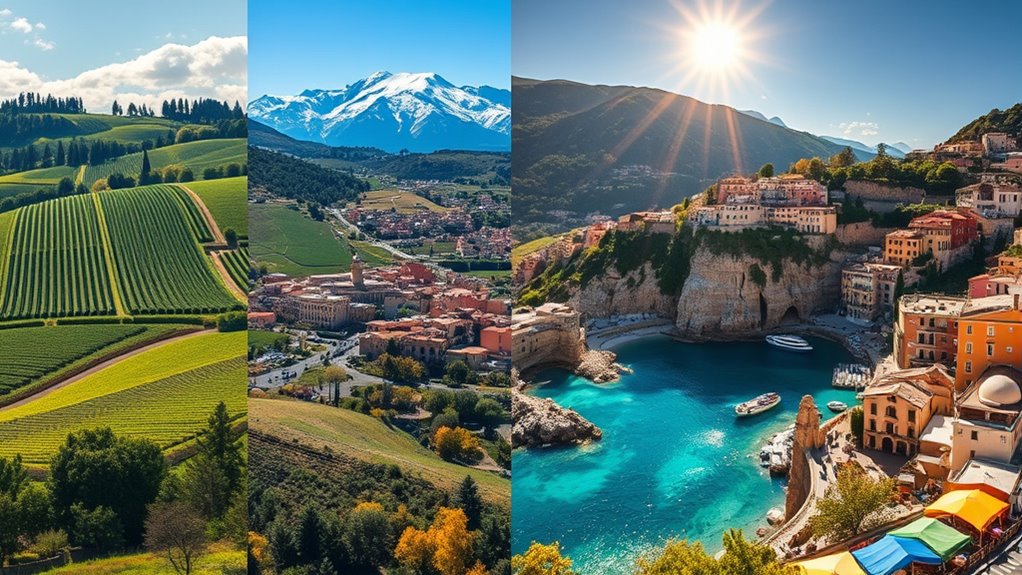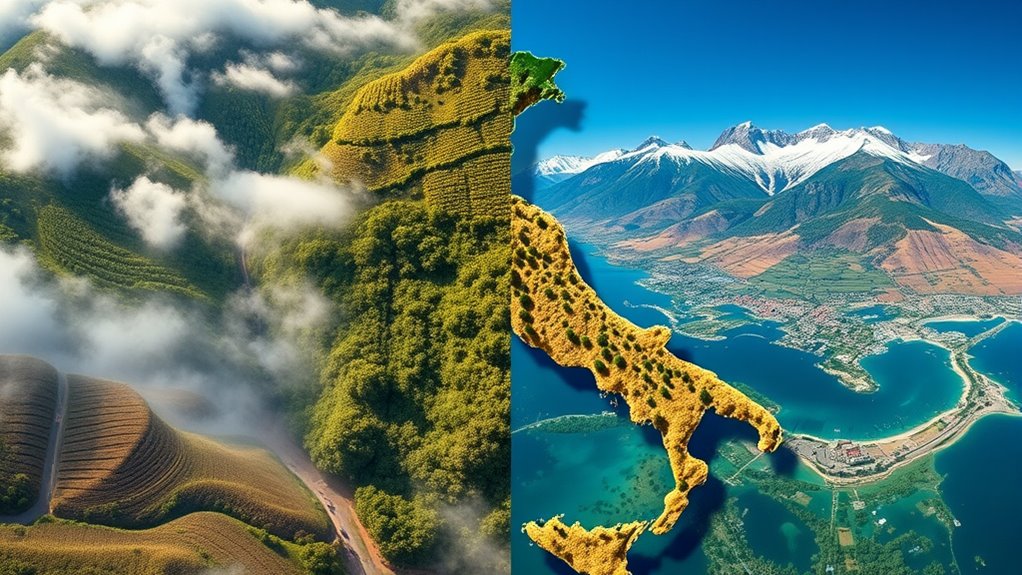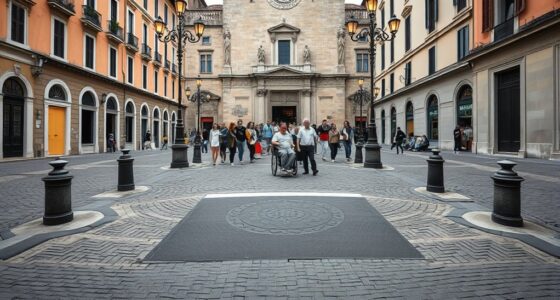Italy’s weather varies widely by region and season. In winter, the north experiences cold temps and snow in the Alps, while the south stays relatively mild. Spring brings melting snow, lush landscapes, and sudden rain, especially inland. Summers are hot, especially in the Po Valley, with coastal areas staying cooler thanks to sea breezes. Mountain areas offer cooler escapes. Exploring these seasonal shifts reveals the country’s diverse climates—keep exploring to discover more about Italy’s unique weather.
Key Takeaways
- Northern Italy experiences colder winter temperatures due to the Alps, while the south remains milder and less affected by cold.
- Spring brings melting snow in the north and increased rainfall, with the south enjoying more sunny, Mediterranean weather.
- Summer sees heatwaves in the Po Valley and cooler mountain climates, with coastal areas benefiting from sea breezes.
- Microclimates caused by mountains, coasts, and plains lead to diverse regional weather patterns across Italy.
- Seasonal changes significantly influence agriculture, outdoor activities, and tourism, reflecting Italy’s varied geography.

Italy’s diverse geography leads to distinct weather patterns across its regions, changing noticeably with each season. As you explore the country, you’ll notice how climate variability shapes local climates, giving each area its unique microclimate. These regional microclimates are influenced by geographical features such as mountains, coastlines, and plains, making Italy’s weather a dynamic and varied experience throughout the year. Additionally, the presence of various microclimates within close proximity allows for a rich diversity of flora and fauna across the country’s landscape. In winter, the north experiences colder temperatures due to its proximity to the Alps. You’ll find snow covering the mountain ranges, creating a stark contrast to the milder, wetter conditions along the Ligurian coast. The Po Valley, a low-lying area, often faces foggy mornings and cold air masses, highlighting how climate variability impacts different microclimates within close proximity. Meanwhile, the south remains relatively warmer, with winter temperatures rarely dropping below freezing, especially along the Mediterranean coast, where a Mediterranean climate prevails. This regional microclimate ensures milder winters that attract visitors seeking refuge from colder conditions elsewhere.
Spring brings a noticeable shift as temperatures rise across Italy. In the north, the snow melts, and the landscape bursts into green with blooming flora. The region’s microclimates become more evident during spring, with some areas experiencing sudden rainfall due to the clash of cold air from the mountains with warmer southern air masses. Central Italy, with its rolling hills and inland valleys, experiences increasing warmth and sporadic showers that nurture vineyards and olive groves. The south begins to warm considerably, with sunny days becoming more frequent, and the Mediterranean influence intensifies, bringing more stable and predictable weather. This seasonal transition highlights how climate variability affects agriculture and outdoor activities across Italy.
Summer in Italy sees the intensification of regional microclimates. The north, particularly the Po Valley, is prone to heatwaves, with temperatures soaring and humidity levels climbing. Coastal regions enjoy cooling sea breezes, which provide relief from the summer heat. In the south, the Mediterranean climate ensures hot, dry days, especially in July and August, with little rain and clear skies. Mountain areas, like the Alps and Apennines, experience cooler temperatures and are popular for summer hiking and skiing in higher altitudes. The variability in summer weather underscores how local microclimates influence lifestyle choices, tourism, and agriculture across Italy. As you traverse the country in this season, you’ll see how the interplay of geography and climate creates diverse weather experiences from one region to another, making Italy a fascinating mosaic of microclimates shaped by seasonal change.
Frequently Asked Questions
How Do Italy’S Climate Zones Affect Local Agriculture?
Italy’s climate zones notably impact local agriculture, shaping what you can grow in each area. In the north, cooler temperatures favor vineyard cultivation and olive groves suited to milder conditions. Central regions support diverse crops, while the south’s warmer climate is ideal for olive groves and vineyards. These climate differences help you produce distinct wines and olives, making Italy’s agriculture unique and vibrant across its diverse regions.
What Impacts Do Seasonal Weather Patterns Have on Tourism?
Think of Italy’s seasons as a storyteller shaping your travel plans. During spring and fall, you experience a gentle whisper of seasonal tourist influx, easing crowds and revealing regional travel preferences. Summer’s warmth beckons beach lovers, while winter’s chill invites alpine adventures. These patterns guide your choices, making each trip unique. Embrace the ebb and flow of Italy’s seasonal rhythm, and you’ll discover a richer, more authentic experience everywhere you go.
Are There Any Regions Prone to Extreme Weather Events?
You should know that some Italian regions are more prone to extreme weather events. For example, southern areas often face regional droughts during dry seasons, impacting agriculture and water supply. Coastal regions, especially along the Adriatic and Tyrrhenian seas, are vulnerable to coastal storms that can cause flooding and damage. Staying aware of these patterns helps you prepare for weather challenges, particularly if you’re planning outdoor activities or travel.
How Does Climate Change Influence Italy’S Seasonal Weather?
Climate change impacts Italy’s seasonal weather by increasing urban heatwaves, making cities hotter and more uncomfortable during summer. You’ll notice changing snowfall patterns, with some areas experiencing less snow and others seeing more unpredictable winter storms. These shifts disrupt local climates and agriculture, affecting daily life. As temperatures rise, expect more extreme weather, which means adapting to new patterns and preparing for more frequent climate-related events across Italy.
What Are the Best Times to Visit Specific Regions?
You should plan your trip based on the best visiting seasons for each region, considering regional climate considerations. Spring (April to June) is ideal for northern Italy’s cities and lakes, offering mild weather and blooming landscapes. Summer (July to August) suits coastal areas like the Amalfi Coast and Sicily for beach activities. Autumn (September to October) provides pleasant temperatures and fewer crowds for wine regions, while winter (December to February) is perfect for skiing in the Alps.
Conclusion
So, after exploring Italy’s diverse weather, you might think you’ve mastered the perfect time to visit each region. Yet, with unpredictable storms in the summer and unexpected frosts in spring, it seems Italy’s weather has a mind of its own. Ironically, no matter how much you plan, the only certainty is that you’ll never quite escape its whims. Just embrace the surprises—they’re part of Italy’s charm, after all.









